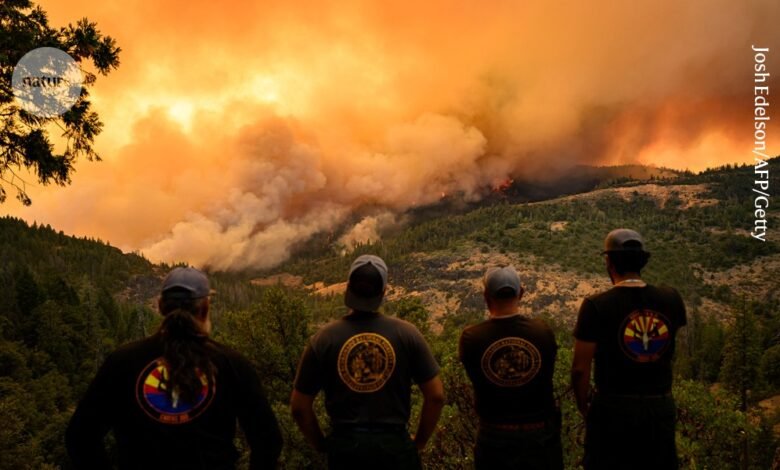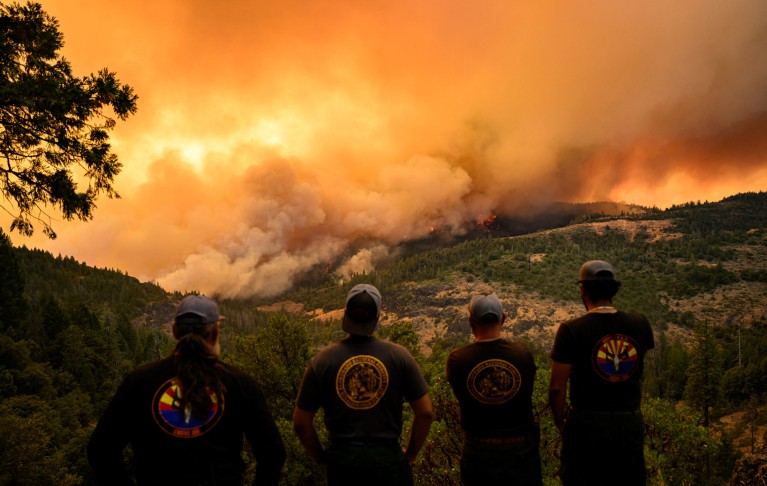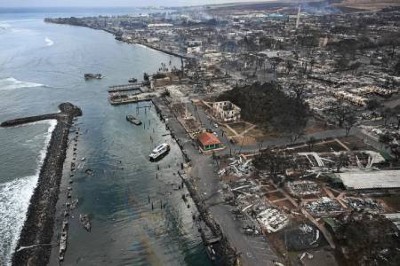

A suspected arson on 24 July ignited the Park Fire in California, which had exploded to more than 140,000 hectares less than three days later.Credit: Josh Edelson/AFP/Getty
The monstrous fires that are now charring vast areas of western North America aren’t just colossal and fast-moving, they have also created their own thunderstorms — an example of exotic fire behaviour that scientists say is becoming more common as the climate changes.
Both the Park Fire, which has burnt more than 160,000 hectares in northern California, and the Jasper Fire, which has destroyed around one-third of the resort town of Jasper in Canada, have spawned ‘pyrocumulonimbus’ clouds, towering formations that can spit lightning, potentially starting more fires.
Reports of such clouds were relatively uncommon in years gone by. Before 2023, the global record was 102 spotted in a single year, 50 of them in Canada, says Mike Flannigan, who studies wildfires at Thompson Rivers University in Kamloops, Canada. During last year’s extremely active fire season, 140 were reported in Canada alone. A higher-than-normal number have also been reported so far this year. “We can expect more of these in the future unless we change our ways,” Flannigan says.
Both the Park Fire and the Jasper Fire also surprised fire officials with the rapidity of their spread — the Jasper Fire, for example, reached the town in half the time that models predicted.
“The sobering reality is that these are not extreme outliers in some ways,” says Daniel Swain, a climate scientist at the University of California, Los Angeles. “We’ve seen a lot of fires behave like these ones in recent years, which I don’t think is reassuring at all.”
Runaway fire
When firefighters first reached the Park Fire near Chico, California, on 24 July, they stood a chance of beating it. The fire, which by some reports had been started deliberately, was still relatively small at just 1–2 hectares. But it soon grew out of control, becoming too large and moving too fast to contain. Within three days, it had burnt more than 140,000 hectares. It is now the fourth-largest fire in state history.
Why are the Canadian wildfires so bad this year?
A couple of days earlier and further north, another fire raced through Jasper National Park in Canada before destroying hundreds of buildings in the town of Jasper. Witnesses described seeing firefighters battling a wall of fire 100 metres tall closing in on the town. So far, one person has died in the Jasper Fire; no deaths have been reported in the Park Fire.
There are three essential ingredients for a large wildfire, says James Gomez, a PhD student studying wildfires at the University of California, Riverside: dry fuel; hot, dry, windy weather; and a source of ignition. Climate change is making two of those more common1. “Conditions will be ideal for fires like these more often,” Gomez says.
Before the Park and Jasper fires started, both regions had been sweltering in extended heatwaves, leaving the forests tinder-dry. Compared with cool air, warm air holds more moisture — about 7% more per degree Celsius — and so draws more water from vegetation on the ground. A warmer climate therefore results in drier fuel2.
“Drier vegetation burns more readily and more intensely, so you have faster-moving fires that are more intense in terms of their thermal output, and the likelihood [is] that they create exotic and extreme fire behaviours,” Swain says.
Fire begets fire
Among those exotic behaviours is the formation of pyrocumulonimbus (pyroCb) clouds3, which Swain calls “dynamos of combustion”. PyroCb clouds generate lightning that can spark dozens of new fires many kilometres from the main blaze, Flannigan says. They can also trigger winds that lead to faster and less predictable fire spread.
Hawaii wildfires: did scientists expect Maui to burn?
This means that fires that breed pyroCb clouds are intense and fast-moving, says Flannigan. The Jasper Fire is one example: when it started, modelling suggested it would take four days to reach the town of Jasper. It got there in two, in part because of the pyrocumulonimbus effect. The modelling system “is built for wind-driven fires, not pyroCbs”, Flannigan says.
The smoke and soot generated by large fires also traps sunlight, making days warmer and drier than normal, says Gomez. That, in itself, can fuel the fire. “It creates a feedback where fires can sustain themselves more,” he says. It can also create conditions that are favourable to the starting of new fires4.
Unintended consequences
Land-management practices over the past 150 years have also contributed to what is known as a fire deficit across much of the western United States, says Swain. Strict fire-suppression practices and the removal of Indigenous peoples from their lands mean that there is now less burning of the landscape than there has been for thousands of years. As a result, forests have become denser.
“Because of these policies, there is more fuel for fires than there would have been,” says Swain. “This is not how the forest would look in its natural state.”
This is less of a problem in Canada, where the forests are naturally denser and population density is lower, says Anthony Taylor, a forest-management specialist at the University of New Brunswick in Fredericton.
The most important measure to prevent these extreme fires is to slow the effects of climate change, scientists say. “We’re on a certain trajectory,” says Taylor. “But there’s still time to not go down that catastrophic road.”






